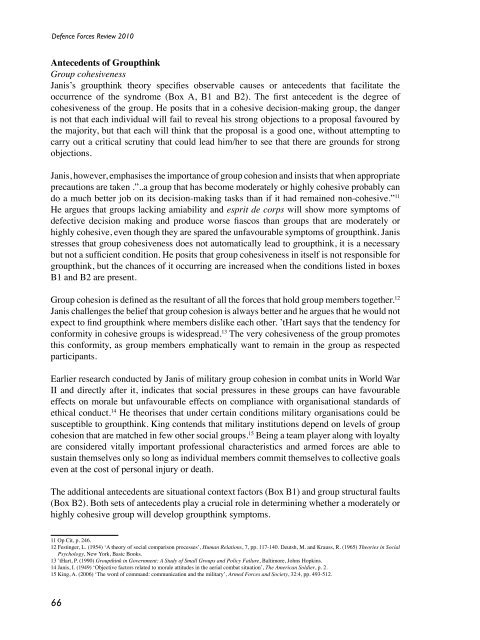Defence Forces Review 2010
Defence Forces Review 2010
Defence Forces Review 2010
Create successful ePaper yourself
Turn your PDF publications into a flip-book with our unique Google optimized e-Paper software.
<strong>Defence</strong> <strong>Forces</strong> <strong>Review</strong> <strong>2010</strong>Antecedents of GroupthinkGroup cohesivenessJanis’s groupthink theory specifies observable causes or antecedents that facilitate theoccurrence of the syndrome (Box A, B1 and B2). The first antecedent is the degree ofcohesiveness of the group. He posits that in a cohesive decision-making group, the dangeris not that each individual will fail to reveal his strong objections to a proposal favoured bythe majority, but that each will think that the proposal is a good one, without attempting tocarry out a critical scrutiny that could lead him/her to see that there are grounds for strongobjections.Janis, however, emphasises the importance of group cohesion and insists that when appropriateprecautions are taken .”..a group that has become moderately or highly cohesive probably cando a much better job on its decision-making tasks than if it had remained non-cohesive.” 11He argues that groups lacking amiability and esprit de corps will show more symptoms ofdefective decision making and produce worse fiascos than groups that are moderately orhighly cohesive, even though they are spared the unfavourable symptoms of groupthink. Janisstresses that group cohesiveness does not automatically lead to groupthink, it is a necessarybut not a sufficient condition. He posits that group cohesiveness in itself is not responsible forgroupthink, but the chances of it occurring are increased when the conditions listed in boxesB1 and B2 are present.Group cohesion is defined as the resultant of all the forces that hold group members together. 12Janis challenges the belief that group cohesion is always better and he argues that he would notexpect to find groupthink where members dislike each other. ’tHart says that the tendency forconformity in cohesive groups is widespread. 13 The very cohesiveness of the group promotesthis conformity, as group members emphatically want to remain in the group as respectedparticipants.Earlier research conducted by Janis of military group cohesion in combat units in World WarII and directly after it, indicates that social pressures in these groups can have favourableeffects on morale but unfavourable effects on compliance with organisational standards ofethical conduct. 14 He theorises that under certain conditions military organisations could besusceptible to groupthink. King contends that military institutions depend on levels of groupcohesion that are matched in few other social groups. 15 Being a team player along with loyaltyare considered vitally important professional characteristics and armed forces are able tosustain themselves only so long as individual members commit themselves to collective goalseven at the cost of personal injury or death.The additional antecedents are situational context factors (Box B1) and group structural faults(Box B2). Both sets of antecedents play a crucial role in determining whether a moderately orhighly cohesive group will develop groupthink symptoms.11 Op Cit, p. 246.12 Festinger, L. (1954) ‘A theory of social comparison processes’, Human Relations, 7, pp. 117-140. Deutsh, M. and Krauss, R. (1965) Theories in SocialPsychology, New York, Basic Books.13 ’tHart, P. (1990) Groupthink in Government: A Study of Small Groups and Policy Failure, Baltimore, Johns Hopkins.14 Janis, I. (1949) ‘Objective factors related to morale attitudes in the aerial combat situation’, The American Soldier, p. 2.15 King, A. (2006) ‘The word of command: communication and the military’, Armed <strong>Forces</strong> and Society, 32:4, pp. 493-512.66
















